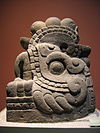Tlalocan
- Tlalocan
-
Le Tlalocan (nom nahuatl qui signifie littéralement « lieu de Tlaloc »[1]) est, dans la mythologie aztèque, le paradis des individus que le dieu Tlaloc a distingués, c'est-à-dire tous ceux dont le décès est de près ou de loin lié à l'eau. En faisaient partie ceux qui avaient été victimes de noyade, de la foudre ou de maladies que l'on supposait être en rapport avec l'eau, telles que l'hydropisie, la gale, la goutte ou encore les maladies vénériennes. Ce lieu est situé dans le Mictlan[2].
Contrairement à la coutume, chez les Aztèques, de brûler les défunts, ces individus étaient enterrés. On plaçait des graines sur leurs mâchoires, on peignait leur visage en bleu et leur dépouille était revêtue de papiers découpés. Le Tlalocan était également la destination des enfants sacrifiés à Tlaloc par noyade.
Le Tlalocan était un endroit verdoyant et humide où régnait un éternel printemps. Tlaloc y régnait avec ses assistants, les Tlaloque.
Ce mythe a été utilisée pour le thème de l'attraction Talocan, situé dans le parc à thèmes allemand Phantasialand.
Notes et références
- ↑ Adela Fernández, Dioses Prehispánicos de México, México, Panorama Editorial, 1998, 162 p. (ISBN 968-38-0306-7)
- ↑ Otilia Meza, El Mundo Mágico de los Dioses del Anáhuac, México, Editorial Universo México, 1981, 153 p. (ISBN 968-35-0093-5)
Catégories :
- Lieu de la mythologie aztèque
- Enfers aztèques
Wikimedia Foundation.
2010.
Contenu soumis à la licence CC-BY-SA. Source : Article Tlalocan de Wikipédia en français (auteurs)
Regardez d'autres dictionnaires:
Tlalocan — is the fourth level of the upper worlds , or heavens , according to the mythic cosmographies of the Nahuatl speaking peoples of pre Columbian central Mexico, noted particularly in Conquest era accounts of Aztec mythology. To the Aztec there were… … Wikipedia
Tlalocan — From Aztec mythology, the paradise where Tlaloc lived … The writer's dictionary of science fiction, fantasy, horror and mythology
Huichol — Infobox ethnic group group=Huichol Wixáritari poptime=Mexico:approx 26,000 popplace=Mexico (Nayarit, Jalisco, Zacatecas, Durango) rels= Shamanism, Animism langs=Huichol, Spanish, related=Cora, Tepehuán, Yaqui, TarahumaraThe Huichol or Wixáritari… … Wikipedia
Tlaloc — Fragments of a brazier depicting Tlaloc from Stage IVB of the Templo Mayor in Mexico City. For the fictional character from the Legends of Dune books, see Titan (Dune)#Tlaloc. Tlaloc (Classical Nahuatl: Tlālōc … Wikipedia
Tzotzil — The Tzotzil Maya of the central highlands of the Mexican state of Chiapas are an indigenous group, the direct descendants of the Classic Maya civilization. The Tzotzil language, like Tzeltal and Ch ol, is descended from the proto Ch ol spoken in… … Wikipedia
Tlaloc — représenté dans le Codex Magliabechiano Nom nahua Tlaloc Traduction en français « Celui qui sème » Coadjuteur Chalchiuhtlicue … Wikipédia en Français
Tláloc — Táloc, Códice Magliabechiano. Tláloc, Colección E. Eug. Goupil, siglo XVII … Wikipedia Español
Tamoanchan — is a mythical location of origin known to the Mesoamerican cultures of the central Mexican region in the Late Postclassic period. In the mythological traditions and creation accounts of Late Postclassic peoples such as the Aztec, Tamoanchan was… … Wikipedia
Totonac — The Totonac people resided in the eastern coastal and mountainous regions of Mexico at the time of the Spanish arrival in 1519. Today they reside in the states of Veracruz, Puebla, and Hidalgo. They are one of the possible builders of the Pre… … Wikipedia
Zapotec languages — Zapotec Diidzaj, Diza, Ditsa, Diidxazá, Tiits Së . . . Spoken in Mexico (Oaxaca, Puebla, Guerrero); USA Native speakers ca 500,000 (date missing) … Wikipedia

